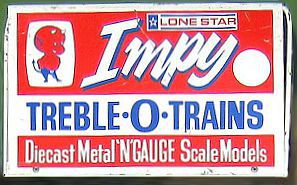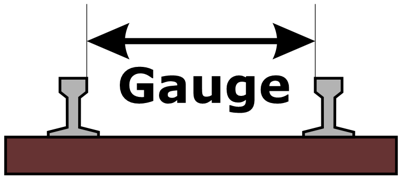Chapter 1: What's N Scale?
It may—or may not—come as a surprise that N Scale didn't simply spring into being overnight from a single source; instead, it evolved over time through a series of accidents and coincidences as ideas sprouted, spread and comingled between multiple companies. Beginning as children's toys, N Scale eventually coalesced into what we know today as the second-most popular model railroading scale in the word.
Scale vs. Gauge
Before digging into the details, however, it's useful to understand some basic terminology, specifically scale and gauge. Sorry to cover old ground for some readers, but there are newcomers joining the hobby every day who can benefit from this information, particularly as it helps one understand certain aspects of N Scale's evolution.
Scale is the size of a real-life object compared to a model. This proportion is expressed as a ratio. Using the example shown above, 1:12 means a model (blue) is 1/12th the size of the real object it represents (green); in other words, it would take 12 models placed end-to-end to match the length of the real thing. There are dozens of modeling scales.
Gauge is the distance between the rails on railroad track—any track, real or model. "Standard gauge" for much of the real world is 4 feet 8.5 inches, but there are dozens of other track gauges, from two-foot narrow gauge to six-foot broad gauge. Likewise, there are dozens of model track gauges, some of which are used for multiple modeling scales.
Gauge and scale are still mixed up to this day, albeit somewhat less frequently. The confusion stems principally from the fact that, in the early days of the hobby, the terms were applied inconsistently by toy manufacturers; this confusion propagated to the toy-buying public, and while most manufacturers have since corrected themselves, some confusion still lingers.



N Scale Defined
So, what exactly is N Scale? For starters, the scale is named after its gauge, which adds to the scale versus gauge confusion: N stands for nine (or neun in German), the track gauge in millimeters. Proportionally it's 1:160—that is, the models are 1/160th the size of real life objects. But, just to add another layer of confusion, it isn't 1:160 everywhere in the world: in the United Kingdom it's 1:148 or 1:152 (British N Scale); in Japan, 1:150 or 1:160 (Japanese N Scale). Why all of the different proportions? In its formative years, there was no standardization of the scale itself, and there was little impetus for manufacturers to use the same proportions; their choices were arbitrary and/or a function of what was practical to manufacture.
 But why 1:160 in the first place? This question has tripped up even modeling historians,
some of whom claim it's because the proportion
neatly matches 2 mm to the foot (why the mix of Metric and English measurements was adopted as a scale designation in the UK I've yet to divine).
But it doesn't; 2 mm to the foot is actually 1:152. Arnold was most likely the driving force for modern-day N Scale:
using a minimum size that was practical to manufacture back in 1960, they settled on a ratio of 1:160 and a gauge of 9 mm, since 1/160 of real-life "standard gauge"
track (4' 8½") is almost exactly 9 mm. While it may seem like an arbitrary choice, arbitrary choices have been the basis of a great many
established "standards" we've come to accept—including so-called
standard gauge track.
But why 1:160 in the first place? This question has tripped up even modeling historians,
some of whom claim it's because the proportion
neatly matches 2 mm to the foot (why the mix of Metric and English measurements was adopted as a scale designation in the UK I've yet to divine).
But it doesn't; 2 mm to the foot is actually 1:152. Arnold was most likely the driving force for modern-day N Scale:
using a minimum size that was practical to manufacture back in 1960, they settled on a ratio of 1:160 and a gauge of 9 mm, since 1/160 of real-life "standard gauge"
track (4' 8½") is almost exactly 9 mm. While it may seem like an arbitrary choice, arbitrary choices have been the basis of a great many
established "standards" we've come to accept—including so-called
standard gauge track.
Opinions vary among modelers as to what legitimately constitutes "N Scale," and the debate has raged for decades. Some insist it only includes models that are 1:160, in spite of the fact that N is not universally 1:160; in fact, there are at least nine variants of the scale. While opinions are, in theory, never wrong, they can create unnecessary conflict, which can verge on a form of scale bigotry; indeed, within days of launching this website, I was taken to task for referring to Treble-0 as N Scale. However, I maintain that to do otherwise is to discard a great deal of related history—besides, the manufacturer did!

Be that as it may, now that some basics about N Scale have been established—confusing and conflicting though they may be—it's time to explore its fascinating origin story.


